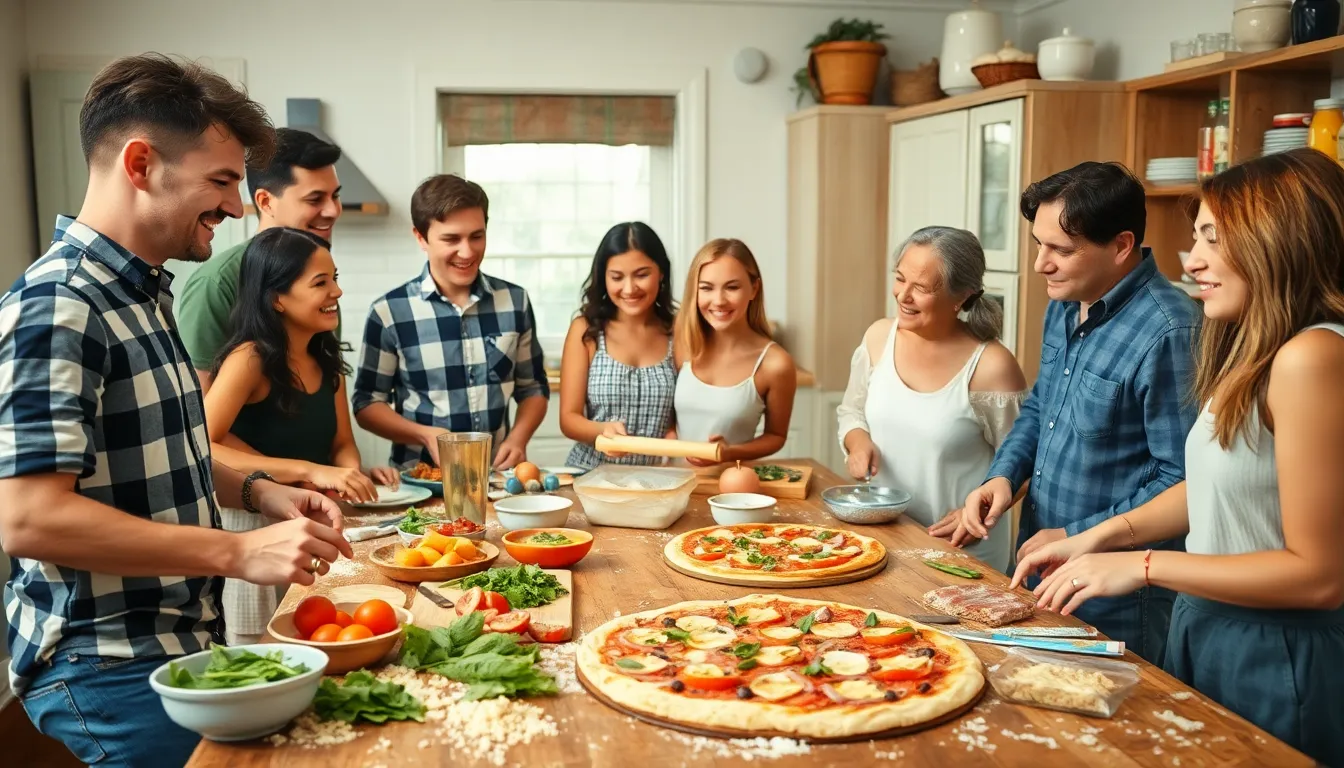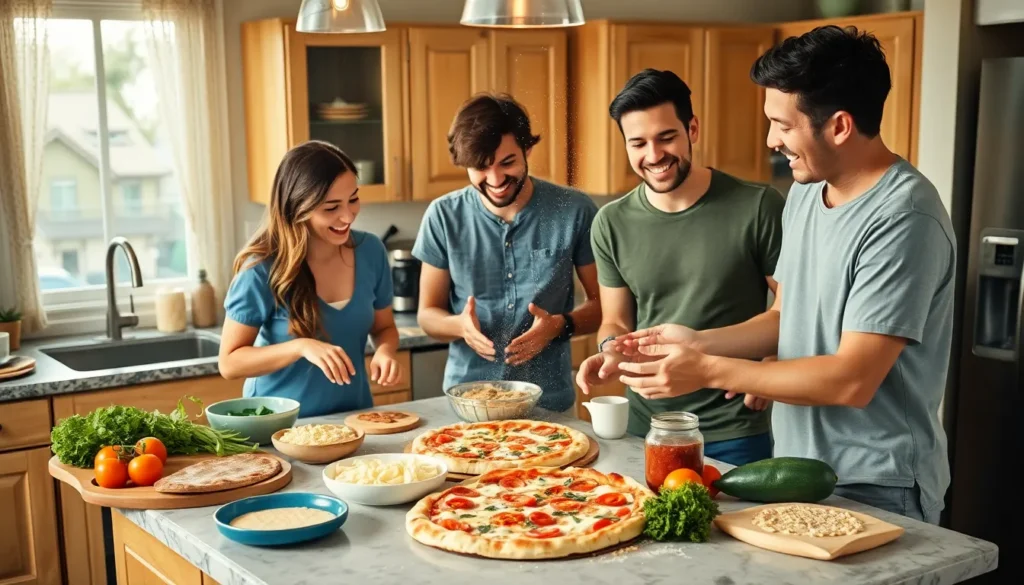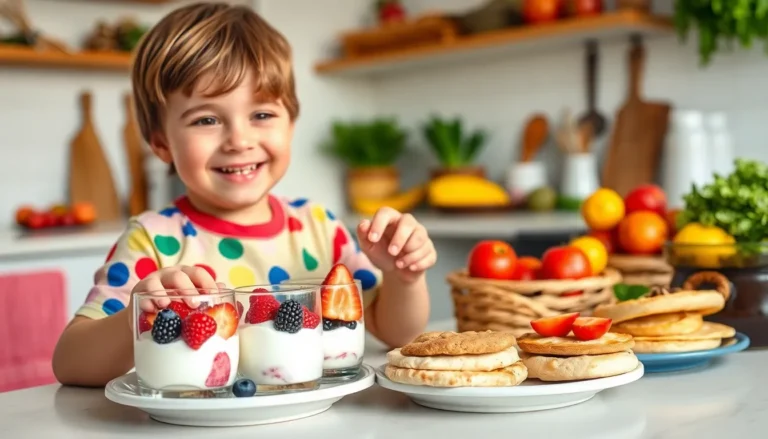Table of Contents
TogglePicture this: a cozy evening with laughter filling the air, the aroma of freshly baked dough wafting through the house, and everyone gathered around the kitchen, ready to unleash their inner pizzaiolo. Homemade pizza night isn’t just dinner; it’s a culinary adventure where creativity knows no bounds. Who wouldn’t want to trade takeout for a night of tossing dough and piling on toppings?
The Joy of Homemade Pizza Night
Homemade pizza night brings excitement to the kitchen. Friends gather, ready to craft personal pizzas with unique toppings. Families embrace the opportunity for creativity, experimenting with various sauces, cheeses, and vegetables. The smell of baking dough fills the air, creating an inviting atmosphere.
Creating dough can be a bonding experience. Participants often find joy in kneading the dough together. Fresh ingredients enhance flavors, making every bite memorable. Toppings like pepperoni, bell peppers, and mushrooms give everyone the chance to customize their creations.
Setting the mood enhances the experience. Soft lighting and playful music contribute to the relaxed vibe. Sharing laughter and stories while crafting pizzas fosters connections among participants.
Competing for the most inventive pizza adds an element of fun. Friendly challenges encourage players to use unconventional ingredients. Different shapes and sizes allow each pizza to showcase personality and flair.
Cleanup can even become part of the fun. Participants often share responsibilities while chatting about their favorite toppings. The night becomes a cherished memory, creating lasting bonds over shared experiences in the kitchen.
Celebrating successes and savoring each pizza takes center stage. Different styles, from Neapolitan to deep-dish, create opportunities for taste exploration. Homemade pizza night transforms an ordinary evening into a creative culinary adventure.
Preparing for Pizza Night

Preparing for a homemade pizza night involves gathering key ingredients and necessary tools, ensuring a smooth and fun experience.
Essential Ingredients
Flour serves as the foundation for the pizza dough. Opt for all-purpose or bread flour for the best texture. Water hydrates the dough, while yeast ensures it rises perfectly. Salt enhances flavor and strengthens the dough. Choose olive oil to add richness and softness to the crust. For toppings, explore various sauces such as tomato or pesto, and select a range of cheeses, including mozzarella and parmesan. Fresh vegetables like bell peppers, mushrooms, and onions offer flavor and vibrancy. Finally, consider meats like pepperoni, sausage, or chicken for added heartiness.
Necessary Tools and Equipment
Essential tools include a mixing bowl for dough preparation. Use a rolling pin to stretch out the dough to the desired size. A pizza stone or baking sheet promotes even cooking, while a pizza cutter simplifies serving. Each participant should have a set of utensils for spreading sauce and adding toppings. An oven thermometer ensures accurate temperature settings, crucial for achieving a perfectly baked pizza. An optional peel simplifies transferring the pizza to and from the oven. Gather these items ahead of time to streamline the cooking process.
Choosing the Perfect Dough
Choosing the right dough sets the foundation for a successful homemade pizza night. A lively discussion about dough types can enhance the experience for everyone involved.
Traditional vs. Gluten-Free Options
Traditional dough relies on refined wheat flour, water, yeast, and salt. This combination produces a chewy texture and a satisfying flavor. Gluten-free options cater to those avoiding gluten, using alternatives like almond flour, rice flour, or a blend of gluten-free flours. These alternatives often need xanthan gum to emulate the elasticity of traditional dough. Each type offers unique textures and tastes, allowing participants to choose according to their preferences.
Tips for Perfectly Rolled Dough
Rolling out the dough evenly ensures a consistent cooking experience. Using a floured surface prevents sticking during preparation. Begin at the center, applying even pressure as you roll outward. Turning the dough periodically promotes an even shape. It’s important to maintain a thickness of about one-quarter inch for optimal results. Measuring ingredients accurately also contributes to dough consistency. Finally, letting the dough rest for at least 30 minutes enhances flavor and makes it easier to handle.
Topping Ideas for Everyone
Creating a variety of toppings for homemade pizza ensures everyone finds something they love. Choices range from traditional flavors to bold, adventurous options.
Classic Combinations
Classic toppings never go out of style. Pepperoni stands out with its zesty flavor, while sausage adds a savory kick. Mushrooms bring an earthy touch, and bell peppers add a refreshing crunch. Mozzarella cheese ensures a creamy base, while a rich tomato sauce enhances each bite. Basil serves as the perfect herb to finish these classic pizzas, imparting a touch of freshness.
Creative and Unusual Toppings
Exploring creative and unusual toppings excites the taste buds. Pesto provides an herby twist, substituting traditional tomato sauce. Feta cheese brings tanginess, pairing wonderfully with spinach. Sweet pineapple complements smoky ham for a delightful contrast. An unexpected choice, figs add a sweet note alongside prosciutto. Finally, jalapeños provide heat and a burst of flavor for those who enjoy spicy bites.
Making the Sauce from Scratch
Creating sauce from scratch elevates homemade pizza night. Fresh ingredients enhance flavor and texture, making each bite memorable. Start with canned whole tomatoes, which offer rich taste and texture. Crush the tomatoes by hand or use a blender for a smoother consistency.
Roasted garlic adds depth to the sauce. For preparation, roast whole cloves until golden brown, then mash them into the tomato mix. Seasoning becomes crucial for a well-balanced sauce. Incorporate salt, pepper, and a pinch of sugar to balance acidity from the tomatoes. Fresh basil contributes an aromatic touch, adding a burst of flavor.
Using olive oil enhances richness. Drizzle a tablespoon into the sauce before mixing other ingredients. Simmer the sauce on low heat for 30 minutes, allowing flavors to meld. Alternatively, cook the sauce longer for a deeper flavor profile. Taste testing during cooking helps adjust seasonings, ensuring the perfect blend.
For spiciness, add red pepper flakes, catering to those who enjoy a kick. Experiment with herbs such as oregano and thyme for added complexity. Consider incorporating onion or bell pepper for sweetness and texture.
Once prepared, let the sauce cool before spreading on the dough. This step prevents the crust from becoming soggy. The homemade sauce not only enriches the pizza experience but also invites creativity and personalization, making every homemade pizza night special.
Cooking Techniques
Cooking techniques play a vital role in achieving the perfect homemade pizza. Understanding the various methods can enhance the overall experience.
Oven-Baking Tips
Using an oven for baking pizza requires attention to temperature and technique. Preheat the oven to at least 475°F for optimal results. Flour the pizza stone or baking sheet to prevent sticking. Slide the pizza into the oven carefully, ensuring an even bake. Checking the pizza after 10 minutes helps to monitor progress, making adjustments if necessary. Creating a crispy crust often involves baking the pizza on the lowest rack, allowing for better heat circulation. Consider using a pizza peel for easy transfers. Experimenting with baking times helps achieve a golden brown finish while ensuring the toppings cook through.
Grilling Your Pizza
Grilling pizza adds a unique smoky flavor, setting it apart from traditional oven-baked options. Begin by preheating the grill on high heat for about 10 to 15 minutes. Rolling out the dough to a slightly thicker texture prevents tearing during grilling. Place the dough directly on the grill grates for 2 to 3 minutes, creating char marks. Afterward, flip the dough and add sauce, cheese, and toppings quickly. Close the grill lid to help melt the cheese while cooking the toppings. Grilling generally requires less time, making it essential to watch closely. This method enhances the crust’s texture, offering a delightful crunch.
Homemade pizza night is more than just a meal; it’s an experience that brings people together. The joy of creating personalized pizzas fosters creativity and strengthens bonds among friends and family. With the right ingredients and tools, anyone can turn an ordinary evening into a memorable culinary adventure.
From crafting dough to experimenting with unique toppings, each step adds to the excitement. Whether it’s the laughter shared during preparation or the satisfaction of enjoying a delicious homemade pizza, this tradition is sure to create lasting memories. So gather loved ones, set the mood, and embark on a flavorful journey that’s bound to become a cherished ritual.







